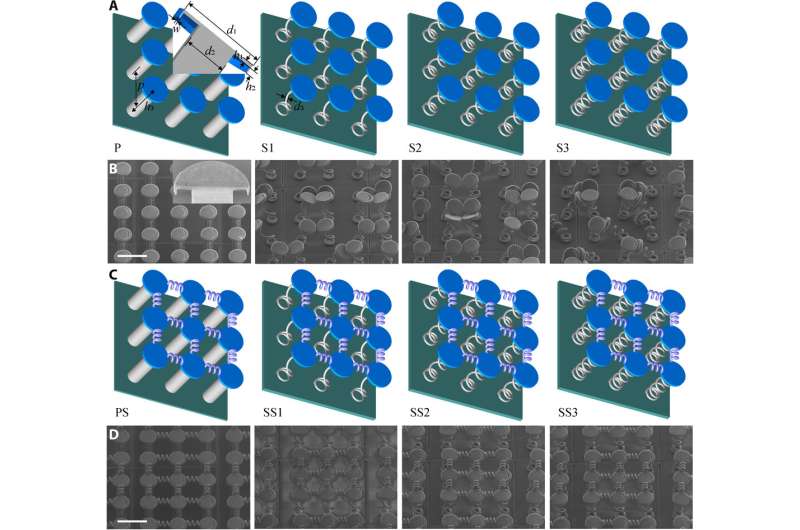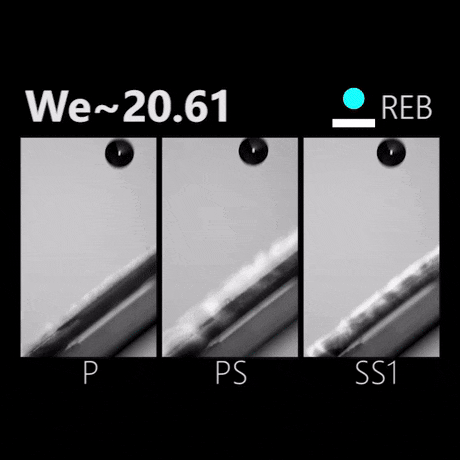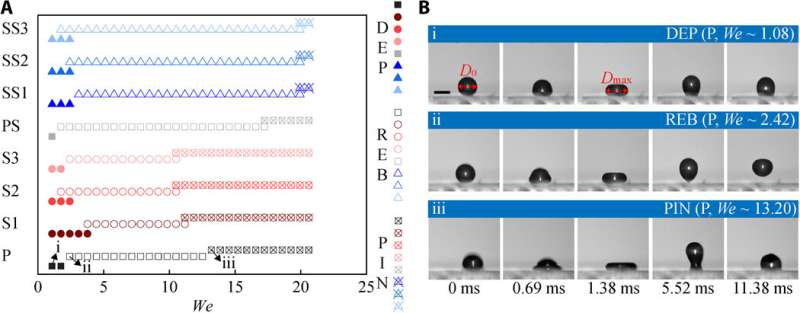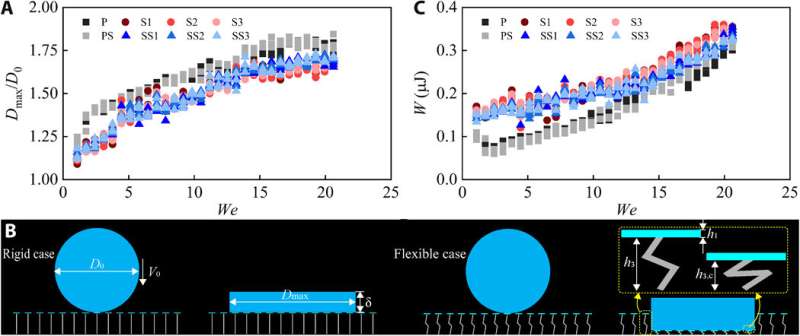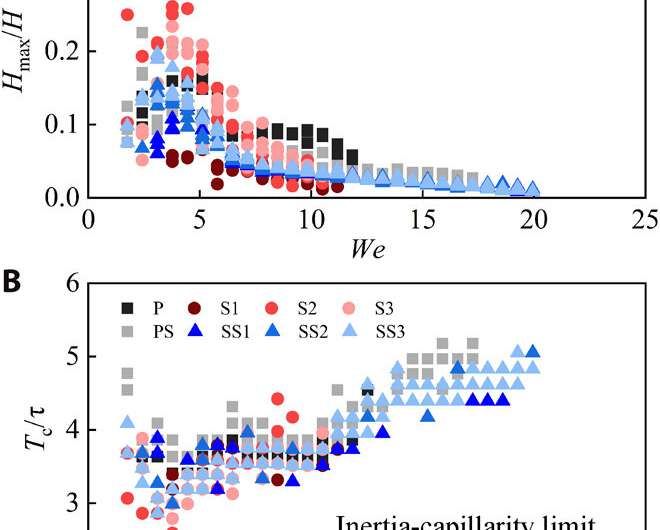Mushroom-spring and mushroom-pillar surfaces. (A and B) Design and fabrication of mushroom-spring flexible surfaces S1, S2, and S3, as well as a mushroom-pillar rigid reference P. (C and D) Design and fabrication of mushroom-spring flexible surfaces SS1, SS2, and SS3, as well as a mushroom-pillar rigid reference PS with horizontal springs to link adjacent heads. Scale bars, 100 μm. Credit: Science Advances, doi: 10.1126/sciadv.aba9721
Artificial surfaces that can repel liquids have attracted significant attention across scientific and industrial platforms to create functional topological features. But the role of the underlying structures that are in contact with liquid droplets is not well understood. Recent developments in micro-nanofabrication can allow researchers to construct a skin-muscle-like system that combines liquid repellence at the interface, alongside a mechanically functional structure. In a new report now published in Science Advances, Songtao Hu and a team of interdisciplinary scientists in China, Switzerland and the U.K., designed bioinspired surfaces with mushroom-like repellent heads using three-dimensional (3-D) direct laser lithography. The flexible, spring-like supports elevated liquid repellence by resisting complex forms of droplet breakdown and reducing droplet-surface contact time. The use of spring-like flexible supports is an unprecedented materials research approach that enhanced liquid repellence for excellent surface control and droplet manipulation. The work extended research on repellent microstructures to yield functional possibilities by linking functional surfaces with mechanical metamaterials.
The interplay between liquid droplets and solid interfaces on artificial liquid-repellent surfaces is important for self-cleaning, anti-icing, and anti-reflection technologies and for principles of water harvesting and droplet manipulation. Researchers are interested in mimicking morphological and chemical characteristics of natural surfaces to fulfill biomimetic performance in the lab. A classic example is the lotus effect, which exhibits waterproofing performance by combining hierarchical morphology and wax-based chemical modifications. To improve the lotus effect in the lab, researchers have mimicked springtail-inspired topology with mushroom-like, flexible heads on top of pillar-like supports to manipulate droplet contact with surfaces. In this work, Hu et al. enhanced liquid repellence using the flexible microstructure design to bridge the gap between two research concepts of functional surfaces and mechanical materials to construct a "skin-muscle-like" system.
Design and fabrication
The top surface of the construct behaved as the skin to receive and respond, while the underlying supports played the muscle role to tune the mechanical properties. The work will trigger a window of opportunity for more functionalities and possibilities by linking functional surfaces with mechanical metamaterials. Using two-photon polymerization, the team tailored 3-D structures on the micro-nanoscale to realize the mushroom-spring design. They modeled the flexible surfaces in SolidWorks first and converted the designs into a stereolithography format for fabrication with a photoresist on an indium tin oxide (ITO)-coated fused silica. The team then coated the surface with chemical vapor deposition to make the flexible springs behave like rigid pillars. Hu et al. also supported a trampoline-inspired surface where vertical springs supported mushroom-like heads and horizontal springs linked the adjacent mushroom-like heads to manipulate the liquid-solid interface.
Obliquely impacting process of droplets. Spreading, retracting, and rebounding behaviors of water droplets impacting mushroom-spring and mushroom-pillar surfaces on a tilted platform with an angle of 45 at We ~ 20.61. Credit: Science Advances, doi: 10.1126/sciadv.aba9721
Preventing droplet breakdown and observing spreading performance
The mushroom-pillar/mushroom-spring surfaces showed excellent anti-penetrant capacity towards static droplets of water and the materials maintained structural hydrophobicity (water repellency) due to their surface coating. The team conducted tests to understand spreading and rebounding behavior of water droplets under diverse velocities of impact and named their forms as depositing (DEP), rebounding (REB) and pinning (PIN) behavior, with an increased We value (a non-dimensionless ratio between inertial and capillary forces). For instance, when the impacting energy increased, the REB behavior inherited the place of DEP to exhibit an effective kinetic resistance to events of impact. The team then calculated the maximum spreading factor as a function of We. The scientists credited the difference in the maximum spreading factor between different surface structures to viscoelastic breaking in soft materials. To further understand the spreading behavior of impacting droplets on microstructures, Hu et al. established a theoretical spreading model, to estimate work done (W) to spread out to a maximum diameter on a flexible or rigid surface.
Post-retraction behavior of droplets impacting mushroom-spring and mushroom-pillar surfaces. (A) Post-retraction behaviors, including depositing (DEP), rebounding (REB), and pinning (PIN), as a function of We. (B) Snapshots exemplarily provided to visualize different post-retraction behaviors over time. Scale bar, 1 mm. Photo credit: S. Hu, Shanghai Jiao Tong University. Credit: Science Advances, doi: 10.1126/sciadv.aba9721
Restitution coefficient and contact time
The scientists then calculated the restitution coefficient, i.e., the ratio of relative velocity between two objects post-collision in the setup, to quantify the remaining kinetic energy of the droplets after lifting off of surfaces. The deposition/rebound (DEP-REB) transitions on such surfaces did not reveal the influence of flexible modification on the restitution coefficient. They discussed the effect of flexible support modifications on the contact time of the droplet, which depended on the position of impact. By immobilizing flexible microstructures on a rigid substrate with efficient fabrication strategies the team overcame shortcomings of droplet contact.
Spreading behavior of droplets impacting mushroom-spring and mushroom-pillar surfaces. (A) Maximum spreading factor Dmax/D0 as a function of We. (B and C) Theoretical spreading model to estimate the work done W in spreading phase and the corresponding results as a function of We. Credit: Science Advances, doi: 10.1126/sciadv.aba9721
In this way, Songtao Hu and colleagues bridged the gap between two research areas of functional surfaces and mechanical materials to implement a skin-muscle-like concept in materials surface engineering. They designed bioinspired mushroom-like waterproof heads on top of spring-like flexible supports to kinetically repel liquid intrusion—suited for a variety of applications. The team proposed an advanced trampoline-like structure to resolve structural instability on droplet contact. They used 3-D direct laser lithography for micro-nano fabrication in order to precisely replicate the flexible surfaces with tunable liquid repellence. While the proposed Nanoscribe technique for high-precision 3-D direct laser lithography offers rapid prototyping technology, the technique must be optimized for large-scale fabrication in practice. The evolving 3-D printing technologies will provide more options for high-throughput centimeter-scale fabrication efficacy.
Restitution coefficient and contact time of droplets impacting mushroom-spring and mushroom-pillar surfaces. (A) Restitution coefficient Hmax/H as a function of We. (B) Dimensionless contact time Tc/τ as a function of We and a theoretical inertia-capillarity limit Tc/τ = 2.2 Credit: Science Advances, doi: 10.1126/sciadv.aba9721
More information: Songtao Hu et al. Liquid repellency enhancement through flexible microstructures, Science Advances (2020). DOI: 10.1126/sciadv.aba9721
Y. Lu et al. Robust self-cleaning surfaces that function when exposed to either air or oil, Science (2015). DOI: 10.1126/science.aaa0946
Hemant Kumar Raut et al. Multiscale Ommatidial Arrays with Broadband and Omnidirectional Antireflection and Antifogging Properties by Sacrificial Layer Mediated Nanoimprinting, ACS Nano (2015). DOI: 10.1021/nn5051272
Journal information: Science Advances , Science , ACS Nano
© 2020 Science X Network
